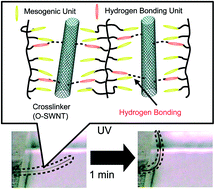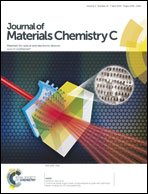Enhancement of mechanical stability in hydrogen-bonded photomobile materials with chemically modified single-walled carbon nanotubes†
Abstract
Uniaxially aligned azobenzene liquid-crystalline polymers crosslinked by hydrogen bonding can deform in response to actinic light. The polymers can be precisely shaped due to high processability of hydrogen-bonded polymers. The mechanical properties of the polymer fibers were improved by introducing single-walled carbon nanotubes as a filler material. Because of weak hydrogen bonding, starting materials can be recovered, reused and recycled, which is very useful in view of chemical resource utilization.

- This article is part of the themed collection: 2014 Journal of Materials Chemistry C Hot Articles

 Please wait while we load your content...
Please wait while we load your content...